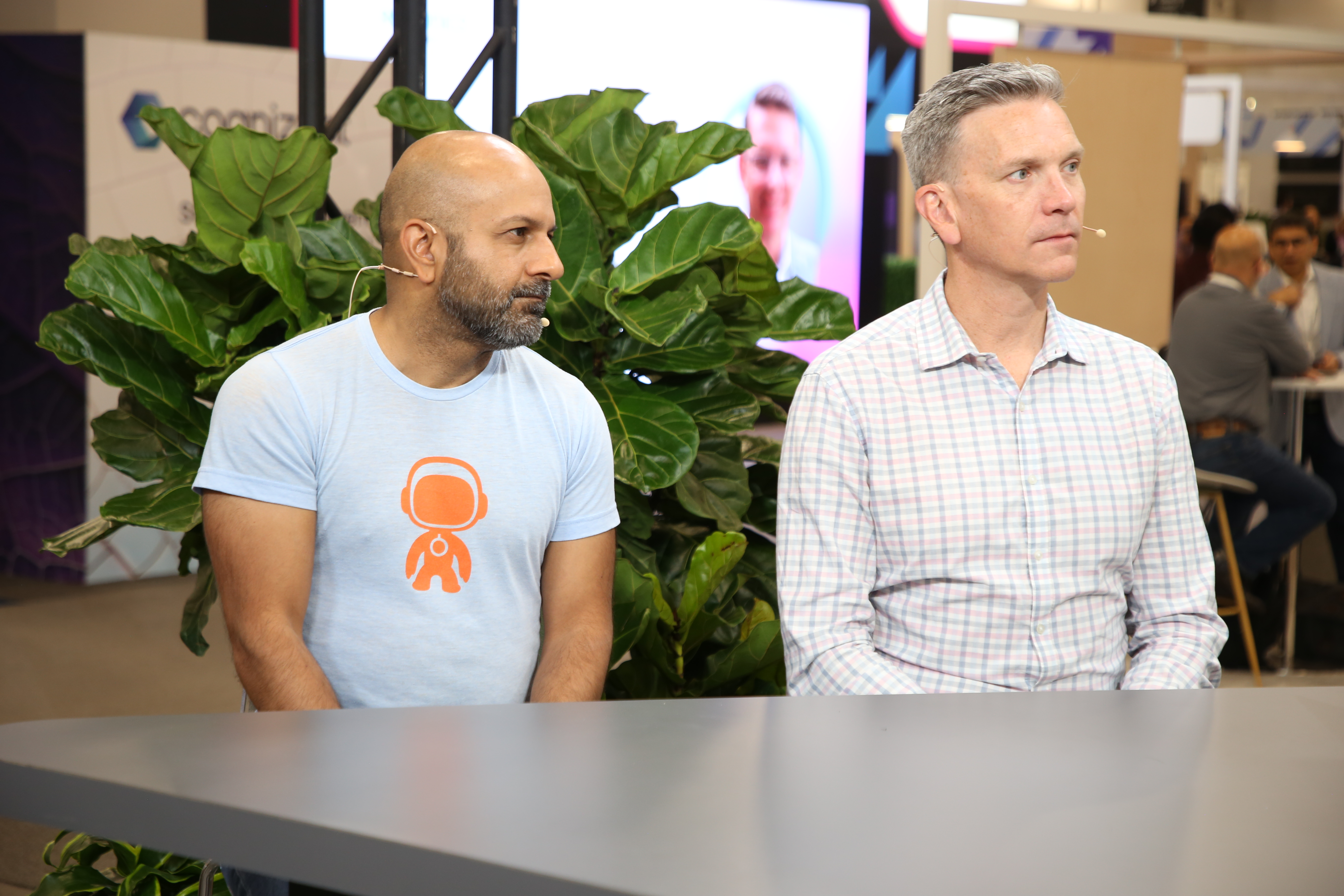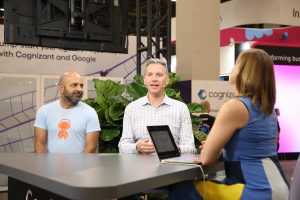 AI
AI
 AI
AI
 AI
AI
Infrastructure has become the frontline for AI-driven commerce, where scale, speed and adaptability decide who thrives.
As unpredictable demand patterns collide with the rise of inference workloads and real-time personalization, businesses are turning to cloud-native infrastructure — especially container orchestration and serverless platforms — to stay competitive. This evolution is redefining how companies deliver seamless customer experiences, forcing engineering and cloud teams into closer alignment to build systems that are not just scalable, but adaptive to sudden, high-stakes surges in traffic, according to Farhan Thawar (pictured, left), vice president and head of engineering at Shopify Inc.

Shopify’s Farhan Thawar and Google’s Drew Bradstock talk with theCUBE about key IT infrastructure supporting AI-driven commerce.
“We work [with Google] to kind of handle these crazy sales that happen, especially like a Black Friday/Cyber Monday, which is for us all [is a] year planning event to make sure it all goes smoothly,” he said.
Thawar and Drew Bradstock (right), senior product director for Kubernetes & Serverless at Google LLC, spoke with theCUBE’s Savannah Peterson for the “Google Cloud: Passport to Containers” interview series, during an exclusive interview on theCUBE, SiliconANGLE Media’s livestreaming studio. They discussed how AI-driven commerce is reshaping infrastructure demands and how Shopify and Google Cloud are partnering to build scalable, adaptive systems that can handle unpredictable traffic spikes, real-time inference workloads and rapid innovation. (* Disclosure below.)
Modern commerce relies on infrastructure that can adapt quickly to unexpected spikes in demand. This adaptability is exactly what Shopify and Google Cloud have been working toward together — leveraging managed platforms such as GKE to optimize for both traditional e-commerce events and the emerging challenges of real-time AI inference. Shopify’s mission to reduce operational toil for entrepreneurs is only possible when the technical underpinnings are agile and resilient, according to Bradstock.
“It’s really changed a lot because if we look at what we’ve done with Shopify for years, we’ve looked at how to make commerce run really well for them,” he explained. “Because the sheer volume that goes through the platform, not just in [Black Friday-Cyber Monday], but through flash sales, like sneaker sales, the number of vendors who are Instagram influencers, the spikes that Shopify would see was immense. But if their system couldn’t handle it in a very short period of time, it was gone. The amount of damage to their merchants was huge. They really pushed us and pushed their own [engineering] teams to do things that were just unheard of, even on the GKE side.”
This push-and-pull dynamic has led to a tightly integrated development loop, with Shopify frequently serving as both a partner and an internal stress test for Google Cloud’s innovations. The lessons learned have real-world impact — not only for Shopify’s millions of merchants, but for any enterprise seeking to scale AI workloads in unpredictable environments, according to Bradstock.
“For inference, it’s the same thing. It’s very similar. You can use your same skills, but completely different because inference doesn’t behave the same way,” he added. “It really comes down to where it’s not predictable. It can be random in terms of the needs, the latency, the more complex the answers that the merchant tasks want, it’s gonna be really variable.”
These challenges have also reshaped how teams work internally. Collaboration has extended beyond shared Slack channels — it’s become a real-time operating model. Shopify’s developers openly communicate their needs, Google Cloud responds with architectural changes, and both parties benefit from candid feedback loops. The success of this relationship hinges not just on technology, but on trust and transparency.
“One of the things that I tell folks is that we use Slack for our communication. We have internal channels, external channels. I kind of just treat them the same,” Thawar explained. “I’m trying to let them know where we’re going. What’s maybe some big merchants coming on or big sales happening and we can trust them with information. We can make sure the infra is ready. I think that’s a big part of it … not trying to feel like our team, their team — it’s just like one team.”
With infrastructure acting as the foundation for scalable AI, companies are realizing that success depends as much on communication as it does on code. Shopify and Google Cloud’s engineering partnership is rooted in rapid feedback cycles, shared risk-taking and a willingness to test emerging technologies in production-like environments, according to Bradstock.
“One of the biggest things is making Kubernetes simple for AI,” he said. “I don’t mean generically, I mean taking the complexity away so companies like Shopify can do that tinkering and exploring so that our customers don’t.”
That culture of experimentation extends to internal processes as well. Whether it’s running surprise scale tests or being early adopters of unreleased hardware, Shopify and Google Cloud continuously iterate to stay ahead of shifting market demands. Their goal: Make infrastructure invisible so merchants can focus on building great products and customer experiences.
“We say AI replaces tasks, not jobs. You can remove that task and just be focused on building a great product — that’s all we’re focused on,” Thawar said. “Using Google allows us to not have to worry about the infrastructure as much and just let our entrepreneurs thrive in our ecosystem.”
The need to innovate isn’t just technical — it’s cultural. Both Bradstock and Thawar pointed to Canada’s foundational role in AI research and emphasized the importance of risk-taking for commercial success. Moving from theory to deployment means embracing failure and iteration — a mindset that’s already reshaping how both companies operate, according to Thawar.
“I think one of the things that, from a culture perspective, is different is in the U.S. you’ll kind of think what could go right. And in Canada we kind of ask what can go wrong. That mindset’s shift is what we’re trying to look for. Try things, tinker. Maybe it fails. Maybe you learn something.”
Here’s the complete video interview, part of SiliconANGLE’s and theCUBE Research’s coverage of the “Google Cloud: Passport to Containers” interview series:
(* Disclosure: TheCUBE is a paid media partner for the “Google Cloud: Passport to Containers” interview series. Neither Google Cloud, the sponsor of theCUBE’s event coverage, nor other sponsors have editorial control over content on theCUBE or SiliconANGLE.)
Support our mission to keep content open and free by engaging with theCUBE community. Join theCUBE’s Alumni Trust Network, where technology leaders connect, share intelligence and create opportunities.
Founded by tech visionaries John Furrier and Dave Vellante, SiliconANGLE Media has built a dynamic ecosystem of industry-leading digital media brands that reach 15+ million elite tech professionals. Our new proprietary theCUBE AI Video Cloud is breaking ground in audience interaction, leveraging theCUBEai.com neural network to help technology companies make data-driven decisions and stay at the forefront of industry conversations.